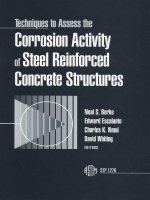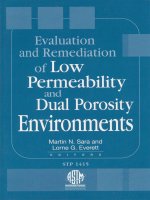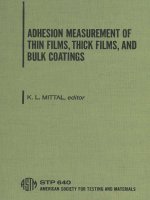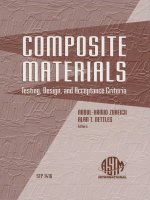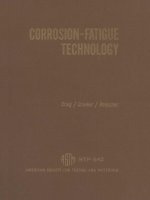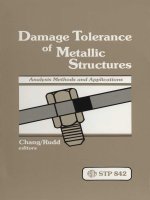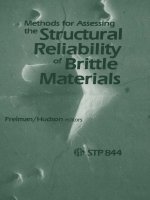Astm stp 531 1973
Bạn đang xem bản rút gọn của tài liệu. Xem và tải ngay bản đầy đủ của tài liệu tại đây (4.25 MB, 205 trang )
Copyright by ASTM Int'l (all rights reserved); Fri Jan 1 23:08:22 EST 2016
Downloaded/printed by
University of Washington (University of Washington) pursuant to License Agreement. No further reproductions authorized.
MANUAL ON REQUIREMENTS.
HANDLING. AND QUALITY
CONTROL OF GAS
TURBINE FUEL
A symposium
presented at the
Seventy-fifth Annual Meeting
AMERICAN SOCIETY FOR
TESTING AND MATERIALS
Los Angeles, Calif., 25-30 June 1972
ASTM SPECIAL TECHNICAL PUBLICATION 531
H. vonE. Doering, chairman
J. A. Vincent, co-chairman
List Price $20.00
04-531000-12
iSlf
AMERICAN SOCIETY FOR TESTING AND MATERIALS
1916 Race Street, Philadelphia, Pa. 19103
Copyright by ASTM Int'l (all rights reserved); Fri Jan 1 23:08:22 EST 2016
Downloaded/printed by
University of Washington (University of Washington) pursuant to License Agreement. No further reproductions authorized.
®by AMERICAN SOCIETY FOR TESTING AND MATERIALS 1973
Library of Congress Catalog Card Number: 72-97871
NOTE
The Society is not responsible, as a body,
for the statements and opinions
advanced in this publication.
Printed in Tallahassee, Florida
October 1973
Copyright by ASTM Int'l (all rights reserved); Fri Jan 1 23:08:22 EST 2016
Downloaded/printed by
University of Washington (University of Washington) pursuant to License Agreement. No further reproductions author
Foreword
The Symposium on Gas Turbine Fuel Requirements, Handling and Quality
Control was presented at the Seventy-fifth Annual Meeting of the American
Society for Testing and Materials held in Los Angeles, Cahf., 25-30 June 1972.
The symposium was sponsored by Committee D-2 on Petroleum Products and
Lubricants, Technical Division D02.C on Turbine Oils. H. vonE. Doering,
General Electric Co., presided as the symposium chairman, and J. A. Vincent,
Standard Oil of Calif., served as the co-chairman.
Copyright by ASTM Int'l (all rights reserved); Fri Jan 1 23:08:22 EST 2016
Downloaded/printed by
University of Washington (University of Washington) pursuant to License Agreement. No further reproductions authorized
Related
ASTM Publications
Effect of Automotive Emission Requirements on Gasoline Characteristics,
STP 487 (1971), $9.50, 04-487000-12
Copyright by ASTM Int'l (all rights reserved); Fri Jan 1 23:08:22 EST 2016
Downloaded/printed by
University of Washington (University of Washington) pursuant to License Agreement. No further reproductions authorize
Contents
Introduction
Operation of Gas Turbines on ASTM 3-GT Fuel-C. E.
HUSSEY,
S. Y. LEE, and W. E. YOUNG
Gas Turbine Operational Experience
Fuel, Deposits and Metallographic Analyses
Laboratory Tests
Test Results and Discussion
Summary and Conclusions
3
4
10
13
16
20
Effect of a Heavy Distillate Fuel on U-700-H. vonE. DOERING
Fuel and Fuel Handling
U-700 First Stage Buckets
Air Quality
Conclusion
22
22
23
25
26
Management of the Gas Turbine Fuel Systems—w. F. WINKLER
Background
Critical Fuel Properties
Fuel Contaminants
Current Fuel Systems
Fuel System Management
Summary
28
29
32
34
37
39
43
Experience with Distillate Fuels in Gas Turbines—R. DEL FAVERO
and J . J . D O Y L E
Current Demands for Distillate Fuels
Problems with Fuel Quality
Changes in Fuel Specifications
Program Objectives and Recommendations
Conclusions
Clean, Bright, and D r y - J . c. BRADLEY
Types of Contamination
Importance of a Quality Assurance Program
Bacterial Contamination
Quality Control System
Conclusions
45
45
46
51
53
55
57
58
59
60
61
72
Electrical Purification of Gas Turbine Fuels—R. W. GREENLEE
and R. N. LUCAS
Electrostatic Purification in the Petroleum Industry
Significant Impurities in Gas Turbine Fuels
Refinery Processes for Impurity Removal
Principles of Dispersion Stability and Electrostatic Separation
On-Site Electrical Treatment of Gas Turbine Fuels
73
74
75
80
87
98
Copyright by ASTM Int'l (all rights reserved); Fri Jan 1 23:08:22 EST 2016
Downloaded/printed by
University of Washington (University of Washington) pursuant to License Agreement. No further reproductions authorized.
Specific Applications of Electrostatic Separation Equipment
Conclusions
101
103
Centrifugal Liquid-Liquid Separation as Applied to Alkali
Metal Reduction in Liquid Fuels by Aqueous Extraction—
A. S. ZAMBONE and C. Y. LEE
105
Nomenclature
Corrosive Metals
Centrifugal Liquid-Liquid Separation
Liquid-Liquid and Liquid-Solid Separation
Brownian Motion
Conclusion
105
106
107
112
115
120
Purification of Fuel Oils by Centrifugal Force-F. H. HILTS
Historical Background
Types of Centrifuges
Selection of Centrifuge Type
Purifier Installation
Temperature Requirements
Prepackaged and Automated Systems
Purification Performance
Fuel Wash Systems
Summary
121
121
122
124
125
125
125
126
129
132
Survey of Trace Metals in Distillate Fuels-C. C. WARD
Discussion of Data
Discussion
133
137
139
Storage Stability of Distillate Fuels for Ships-E. w. WHITE
Technical Background
Test Procedures
Cumulative Results
Discussion
Findings and Tentative Conclusions
Future Plans
143
144
148
153
154
165
165
Analysis of Fuel Oils for Trace Metals-H. A. BRAIER
General Considerations on Trace Analysis
Analytical Methods
Conclusion
Discussion
167
167
170
184
187
Problems Associated with Vanadium Determination in Heavy
Distillate Fuels-J. F. BOYLE
191
Discussion
Summary
Copyright
by
Downloaded/printed
University
of
191
197
ASTM
Int'l
(all
by
Washington
(University
rights
reserved);
of
Washington)
Fri
pursuant
Jan
to
L
STP531-EB/Oct. 1973
Introduction
Trace metals in fuels can be detrimental to the operating reliability of gas
turbines particularly with the use of higher firing temperatures and stronger but
less corrosion resistant hot section alloys.
Limiting these trace metals in distillate fuels by specifications on refinery
production does not assure that the fuel is free of trace contaminants as
delivered to the turbine because such impurities may be introduced during
transportation and storage. Clean fuels free of troublesome trace metals are more
likely to be available to turbine users if careful handling, appropriate cleanup
procedures particularly at the point of use and routine trace metal analysis of
the fuel are employed.
The purpose of this symposium, held in Los Angeles, 28, 29 June 1972, was
to give the user, the transporter, and the refiner both fundamental and practical
aspects of what can be done to provide cleaner fuels to gas turbines. It explored
the nature and source of impurities, their measurement and effect on turbine
performance as well as their control and removal. No single set of procedures can
be recommended for all installations. However, none can be effectively selected
or employed, unless the principles, capabiHties, and Hmitations are understood.
H. vonE. Doering
General Electric Co.,
Schenectady, N. Y.
/. A. Vincent
standard Oil of Calif,,
San Francisco, Calif.
Copyright
by
ASTM
Downloaded/printed
by
Copyright 1973 by AS FM International
University
of
Washington
Int'l
(all
www.astm.org
(University
rights
of
reserved);
Washington)
Fri
pursuant
C. E. Hussey,^ S. Y. Lee,^ and W. E. Young^
Operation of Gas Turbines
onASTMS-GTFuel
REFERENCE: Hussey, C. E., Lee, S. Y., and Young, W. E., "Operation of Gas
Turbines on ASTM 3-GT Fuel," Manual on Requirements, Handling, and Quality
Control of Gas Turbine Fuel, ASTM STP 531, American Society for Testing and
Materials, 1973, pp. 3 - 2 1 .
ABSTRACT: In 1965 two Westinghouse W171 gas turbines at the Miraflores station
of the Panama Canal Co. were overhauled and put into service burning a locally
available "Low Vanadium Special Fuel." The purchase specification was: sodium
(less than 10 ppm), vanadium (less than 4 ppm), calcium (less than 10 ppm), and
sulfur (less than 1.8 percent). Although some corrosion, even at the reduced turbine
inlet temperature of 1375 F was anticipated, it was hoped that the damage would be
minimal, thereby justifying the use of this fuel with its definite price advantage.
However, after 6375 h of operation, an inspection indicated that corrosion had
become extensive.
In 1966 the turbines were again overhauled and put back in service on the same fuel
but in a treated state. Periodic sampling and analysis was carried out, and except for
one brief excursion, the vanadium averaged 2.5 ppm and the sodium less than 0.5
ppm. After nearly 5000 h of operation, an examination showed only minor corrosion
to a completely acceptable extent and the machines have continued to run under
these conditions since 1967.
During this period, extensive laboratory tests were made in a pressurized passage
which simulates gas turbine operation to set safe operating limits for the use of
various grades of fuel in actual engines. In addition, an attempt was made to obtain
quantitative corrosion measurement of the actual turbine blade by means of a device
called "dipstick." It was shown that with a surface temperature of 1500 F together
with a 5 ppm sodium/2 ppm vanadium fuel an excessive amount of attack would
occur.
It may be concluded that in a modern high temperature gas turbine operating under
base load conditions the use of a type 3-GT fuel as defined in ASTM Specifications
for Gas Turbine Fuel Oils (D 1880-71) will lead to frequent blade and diaphragm
replacement. Under some conditions, the turbine will tolerate a fuel with as much as
1 ppm each of sodium and vanadium. Satisfactory operation should result with a fuel
as high as 2 ppm in vanadium content if the sodium is lowered by appropriate
treatment to less than 0.5 ppm.
KEY WORDS: gas turbines, corrosion, fuels, specifications, heat resistant alloys,
sulfidation, vanadium, sodium
From a combustion standpoint, gas turbines are capable of burning almost any
type of liquid or gaseous fuel. However, it has been found that certain other fuel
characteristics are overriding causing such deleterious effects as corrosion and
Senior combustion engineer, Westinghouse Gas Turbine Systems Division, Lester, Pa.
19113.
9113.
Senior research engi
engineer and manager, respectively, Westinghouse Research Laboratories,
Pittsburgh, Pa. 15235.
Copyright
by
Downloaded/printed
Copyright 1973
University
of
ASTM
by
Washington
by A S T M International
Int'l
(all
www.astm.org
(University
rights
of
reserved);
Washington)
Fri
pursuant
Jan
to
4
GAS TURBINE FUELS
fouling, when fuels other than light distillates, No. 2 distillate, and natural gas
are burned. This corrosion may take place as oxidation or sulfidation and is
intensified by certain contaminants in the fuel such as organic vanadium and
alkalis such as sodium and potassium salts. During combustion, vanadium may
form a corrosive pentoxide, and the alkali metals may form sulfates which are
both corrosive and deposit forming. In some instances, the vanadium and sodium
may combine to form an even more corrosive sodium vanadate. All of these
compounds have low melting points which is a prerequisite for deposit
formation or catastrophic corrosion or both.
For several years the gas turbine has played a major role as a peak power
generator, and in this type of service its use of higher grade fuels was acceptable.
There is now, however, an increasing tendency to run gas turbines for longer
than peak schedules, approaching sometimes base load operation. The use of
lower grades of fuel then becomes economically desirable. There has emerged a
family of low sulfur heavy fuels containing a low level of contaminant such as the
ASTM No. 3-GT class as listed in ASTM Specification for Gas Turbine Fuel Oils
(D 2880-71). The specification permits up to 5 ppm sodium and 2 ppm
vanadium. Certain crudes, high-boiling distillates, and even some residuals can
meet this specification. There is also a true residual grade fuel, namely, ASTM
No. 4-GT, but it is recognized that such a fuel will require treatment in the form
of water washing or chemical addition or both to make it suitable for gas turbine
consumption. Therefore, it is of interest to explore the possibilities of using No.
3-GT fuels with low contaminant levels, setting safe operating limits for the gas
turbine. This review brings together past work [1-3] ^ that concerned itself with
the evaluation of the high temperature corrosive effects of fuels that are close to
or at the limits set out by ASTM D 2880-71 for No. 3-GT fuel oil. The first
section [7] will deal with actual gas turbine experience with fuels close to the
ASTM No. 3-GT specification considering the limits for potentially corrosive
chemical elements. Next section will report on experiments [2,3] that were
designed to measure the corrosive effects of sodium and vanadium at the
suggested levels of the specification as an aid in setting safe operating conditions.
Finally, a "dipstick" is described. This is a device that was installed in an
operating gas turbine in an effort to determine when the level of corrosive attack
was becoming excessive.
Gas Turbine Operational Experience
Ratings
The two gas turbines under consideration in this review are Westinghouse type
W171G each with a rated output of 10.8 MW at a nominal turbine inlet
temperature of 1375°F. Peak temperatures at the first stage stators may be
1450°F due to normal stratification of the gas stream at the discharge of the
The italic numbers in brackets refer to the list of references appended to this paper.
Copyright by ASTM Int'l (all rights reserved); Fri Jan 1 23:08:22 EST 2016
Downloaded/printed by
University of Washington (University of Washington) pursuant to License Agreement. No further reproductions authorized.
HUSSEY ET AL ON OPERATION OF GAS TURBINES
5
combustion system. The materials in the gas turbine blade path that are of
particular interest with respect to corrosion are:
First Stage
First Stage
stator vanes
rotating blades
Second Stage
Second Stage
Remaining
Remaining
stator vanes
rotating blades
stator vanes
rotating blades
Udimet 500
INCO 700 (Turbine No. 1)
Udimet 520 (Turbine No. 2)
Udimet 500
Inco 700
A1S1310
Inco X
Early Experiences
The initial operation of these gas turbine units was with a fuel known as Navy
Special. This fuel required a water wash system to remove sodium, and a
magnesium additive system for treatment of the high vanadium content in the
fuel. During the first year of operation with this fuel, operational difficulties
were encountered due to deposit buildup in the turbine blade path resulting
from the additive used for the inhibition of corrosion from the vanadium attack.
Since the operation of these gas turbines was essentially base load, which
precluded frequent cleaning (or shutdown to spall off deposits) of the turbine
blade path to restore power, it was decided to change to a locally available fuel,
known as a "Low Vanadium Special," which would possibly require no
treatment and yet have a similar price structure to the Navy Special Fuel. The
purchase specification for this fuel was: sodium (less than 10 ppm), vanadium
(less than 4 ppm), calcium (less than 10 ppm), and sulfur (less than 1.8 percent).
Although some corrosion, even at the reduced turbine inlet temperature of
1375°F was anticipated, it was hoped that the damage would be minimal,
thereby justifying the use of this fuel with its definite price advantage.
First Year of Operation on Low Vanadium Special Fuel (1965 to 1966)
After an overhaul the two turbines were placed on line with the Low
Vanadium Special Fuel and one turbine was inspected after 2480 h operation,
when it was reported that no major deterioration had taken place on the stators,
that is, no visible corrosion. The first-stage rotating blades, however, showed a
pitted surface on the pressure side and the entire blade path was reported to be
coated with a gray-green deposit. A further visual inspection was made through a
combustor basket after an additional 2700 h when it was observed that the
first-stage diaphragm showed serious damage. The gas turbines were shut down
for general overhaul after 6375 h operation.
Condition at Overhaul
The general condition of the turbines after this year's inspection disclosed that
extensive corrosion had occurred on the first stator vanes of Udimet 500; the
vane sections were ragged where metal had been eaten away to the hollow core.
Copyright by ASTM Int'l (all rights reserved); Fri Jan 1 23:08:22 EST 2016
Downloaded/printed by
University of Washington (University of Washington) pursuant to License Agreement. No further reproductions authorized.
6
GAS TURBINE FUELS
The second-stage Udimet 500 stator vanes showed heavy surface corrosion
similar to the first stage, but the general condition was less severe. Both the first
and second row turbine blades showed heavy oxidation scale with evidence of
surface corrosion. Figures 1 and 2 illustrate the general condition.
FIG. l-First-stage Udimet 500stator, 1965 to 1966.
Reviewing the operational history and analyses of the fuel as supplied by the
refinery showed the average vanadium content to be 2.8 ppm with peaks to 3.8
ppm. The sodium content averaged 2 ppm except for 6 out of 22 shipments
where this value ranged from 4 to 10 ppm. The average water content was 0.1
percent. The analyses carried out by the operator generally agreed with those
from the refinery except for a few exceptions which are worthy of note.
Early in the year's operation it was discovered that an appreciable amount of
sea water was present at the bottom of the fuel storage tanks. The tanks were
dfained and cleaned out at this time. Also, several of the operators' analyses
showed vanadium concentrations of up to 11.5 ppm and these tended to
coincide with the transportation of residual fuel, which had a vanadium levels of
the order of 200 ppm, through the common pipeline from the tankers to the
station.
Copyright by ASTM Int'l (all rights reserved); Fri Jan 1 23:08:22 EST 2016
Downloaded/printed by
University of Washington (University of Washington) pursuant to License Agreement. No further reproductions authorized.
HUSSEY ET AL ON OPERATION OF GAS TURBINES
7
FIG. l-First stage Inco 700 rotating blade. 1965 to 1966.
When the turbines were opened up for overhaul, deposits were collected from
locations throughout the flow path and were submitted for detailed chemical
analysis; and sample vanes and blades were obtained for metallographic analysis.
In general, these analyses showed that the turbine blade materials had suffered
from a type of attack that has been typically described in the literature as hot
corrosion or sulfidation. In particular, metallographic analysis of the first-stage
stator of U-500 showed that a large proportion of the affected area next to the
unaffected alloy contained gray islands of CrS^ that are typical with this type of
corrosion. In addition, there was evidence of thick oxide layers. X-ray
diffraction analysis of the deposits indicated some compounds, either singly or
in combination, that are known to be corrosive. Table 1 lists the compounds
that were found in the turbine blade path.
Of most interest in Table 1 is the compound, sodium vanadyl vanadate. This
compound has been reported in the literature [4,5] as being extremely corrosive
at temperature levels above 1200°F. In addition, vanadium pentoxide and
sodium metavanadate are known to be corrosive. The corrosion mechanism of
all these compounds is described as essentially an accelerated oxidation process.
The presence of the magnesium and sodium compounds in the form of sulfates
could alone account for the observed sulfidation corrosion.
Copyright by ASTM Int'l (all rights reserved); Fri Jan 1 23:08:22 EST 2016
Downloaded/printed by
University of Washington (University of Washington) pursuant to License Agreement. No further reproductions authorized
8
GAS TURBINE FUELS
TABLE 1 -X-ray diffraction analysis of deposits collected from locations throughout the
flow path after 1965 to 1966 operation.
Na2S04
Na2Mg(S04)2 • 4H2O
MgS04
Na2 0 • V2O4 • 5V2O5
Na20 • V2O5
V2OS
(VO)2S04 • I6H2O
Vi2026(2V204 • VjOs)
NiO
sodium sulfate
sodium magnesium sulfate
tetrahydrate
magnesium sulfate
sodium vanadyl vanadate
sodium metavanadate
vanadium pentoxide
vanadyl sulfatehexadecahydrate
vanadyl vanadate
nickel oxide
Thus, it appeared from these analyses that the corrosion was one of sulfidation
due to the sulfate compounds that were present and that this sulfidation
corrosion process had been enhanced by an accelerated oxidation process in
presence of complex sodium vanadium vanadates.
Since a precise knowledge of the turbine environment was not known during
this experience, it was recommended to the operator that certain precautions be
taken for in the future use and that a carefully controlled operation be carried
out to more fully evaluate the effects of operating with this particular fuel.
These recommendations were;
1. Overhaul the turbines to the "as new" condition.
2. Reduce the allowable sodium in the fuel to 5 ppm.
3. Reactivate the water-washing plant to further reduce the sodium level to a
minimum.
4. Pay particular attention to pipeline purging and drainage of storage tanks.
5. Institute regular fuel analysis.
6. Monitor the intake air.
Second Year of Operation (1966 to 1967j
Both machines returned to service after the overhaul and were shut down for
inspection after completing an additional 5000 h. The results showed a major
improvement over the previous year's operation, although the two machines did
show slight differences.
Turbine No. 1
On the No. 1 machine, which was inspected first, the first-stage diaphragm
showed some evidence of corrosion on the blades with the greatest concentration being on the pressure side of the blades at areas corresponding to the
horizontal joint in the diaphragm. Only two leading edges showed any evidence
of corrosion. There was virtually no visible evidence of corrosion on the
remaining stationary or rotating blades.
Copyright by ASTM Int'l (all rights reserved); Fri Jan 1 23:08:22 EST 2016
Downloaded/printed by
University of Washington (University of Washington) pursuant to License Agreement. No further reproductions authorized.
HUSSEY ET AL ON OPERATION OF GAS TURBINES
9
Turbine No. 2
After No. 1 turbine was shut down, the No. 2 turbine was operated^for an
additional 450 h. The general condition was good by comparison to the previous
year, but not quite as good as the No. 1 turbine. After vapor blasting, the
pressure sides of the first-stage stator showed general corrosion as shown in Fig.
3. Interestingly, the suction side, as shown in Fig. 4, does not show any visible
surface attack.
FIG. Z-First-stage Udimet 500 stator pressure side, 1966 to 1967.
The remainder of the turbine was in excellent condition with no visible
corrosion as illustrated by Fig. 5 showing the condition after vapor blasting of
the first-stage rotating blades.
This rate of corrosion experienced after the second year of operating appeared
to be more in line with what might be expected with the level of corrosive
contaminants found. Deposits were collected throughout the flow path, together
with sample rotating blades for chemical and metallographic analysis, which is
discussed later in the paper.
Copyright by ASTM Int'l (all rights reserved); Fri Jan 1 23:08:22 EST 2016
Downloaded/printed by
University of Washington (University of Washington) pursuant to License Agreement. No further reproductions authorized.
10
GAS TURBINE FUELS
FIG. '^-First-stage Udimet 500 stator, 1966 to 1967.
Fuel, Deposit and Metallographic Analyses
Fuel Supply and Analysis
At the particular location in question the fuel is pumped from a tanker some
five miles away, to a storage tank at the site. The fuel then passes through a
water wash fuel treatment plant to lower the sodium concentration and then to
a smaller storage tank from which it is delivered to the two gas turbines.
Weekly fuel samples were obtained by the operator who analyzed for water
content, sodium, and vanadium in his own laboratory. In addition, monthly fuel
samples were returned to Westinghouse for full chemical analysis. The
correlation between the two sets of analyses were within 0.5 ppm for sodium
and within 1 ppm for vanadium, which is considered satisfactory. The average
concentration for sodium plus potassium, which is limited by the proposed
ASTM specification, was 0.85 ppm. The average for vanadium was 1.97 ppm. A
summary of the average physical and chemical properties of the fuel used for the
1966 to 1967 operation is given in Table 2, together with a comparison of the
ASTM fuel specifications for No. 3-GT fuel.
Copyright by ASTM Int'l (all rights reserved); Fri Jan 1 23:08:22 EST 2016
Downloaded/printed by
University of Washington (University of Washington) pursuant to License Agreement. No further reproductions authorized
HUSSEY ET AL ON OPERATION OF GAS TURBINES
.ãV. -
"T-"
11
ã ãT^*'
ƠIG. 5-First-stage
Udimet 520 rotating blade, 1966 to 1967.
TABLE 2-Average fuel properties for 1966 to 1967.
Gas Turbine
Fuel
Physical Properties
Specific gravity, deg API 60/60° F
Viscosity, SUV at 100° F
Water and sediment percent by volume
Ash percent by weight
Chemical Properties
Sodium plus potassium, ppm
Vanadium, ppm
Calcium, ppm
Lead, ppm
Magnesium, ppm
Sulfur, percent by weight
ASTM D 2880-71
No. 3-GT
27.4
145
0.12
0.001
0.85
1.97
0.38
0.02
0.26
1.2
300 max."
1.0
0.03
5
2
10
5
0.7
" Furolat 122° F.
Copyright by ASTM Int'l (all rights reserved); Fri Jan 1 23:08:22 EST 2016
Downloaded/printed by
University of Washington (University of Washington) pursuant to License Agreement. No further reproductions authorized.
12
GAS TURBINE FUELS
Because these turbines were located relatively near the sea and also because of
the proximity to the gas turbine intake of a chemical treatment plant using
sodium compounds, the intake air was also monitored during this year's
operation. However, no significant ingestion of harmful chemical elements was
noted—the sodium level was less than 0.02 ppm equivalent in the fuel.
Deposit and Metallographk Analysis
From the summary of fuel oil and inlet air analyses that were determined
during the course of this year's operation, it appears reasonable that these
conditions represent the average environment under which the observed
corrosion occurred. It is interesting to compare these results with those of
previous years, in light of deposits and metallographic analyses.
First, the deposit level was considerably less than had been observed
previously. An X-ray diffraction analysis of these deposits is shown in Table 3.
TABLE 3 ~X-ray diffraction analysis of deposits obtained after 1966 to 1967 operation.
NiFe204
3Nio-V205
Fe203
Ni (V03)2
NiO
V2O5
V2O4
Na2Mg(S04)2'4H20
CoS04-6H20
3C0V2O5
nickel iron oxide
nickel orthovanadate
iron oxide
nickel vanadate
nickel oxide
vanadium pentoxide
vanadium tetroxide
sodium magnesium sulfate tetrahydrate
cobalt sulfate
cobalt orthovanadate
Aside from the fact that more corrosion products were distinguished in the
analyses as compared to those listed in Table 1, the conspicuous absence of any
of the complex sodium vanadium vanadates is noteworthy. As stated before, it is
believed that these compounds can accelerate the corrosion process to
catastrophic levels. Any combination of circumstances which will reduce the
propensity for the formation of the sodium vanadate compounds should reduce
the rate of corrosion attack. This is believed to be the case in the observed
difference in corrosion rates. However, it can be seen that vanadium is still
observed as the oxide and as a participant in the corrosion products. Thus, at an
average level of 2 ppm of vanadium, it would appear that vanadium (in the form
of V2O5) can still be a factor for inducing corrosion attack.
Additional Operation
The turbines were examined visually again in 1968 after a total operating time
of approximately 12 000 h. No further corrosion was noted at this inspection,
nor at any time since then.
Copyright by ASTM Int'l (all rights reserved); Fri Jan 1 23:08:22 EST 2016
Downloaded/printed by
University of Washington (University of Washington) pursuant to License Agreement. No further reproductions authorized.
HUSSEY ET AL ON OPERATION OF GAS TURBINES
13
Despite the small amount of observed corrosion, the diaphragms were returned
to service after this inspection. The type of corrosive attack seen on the
first-stage stators could not be positively identified. However, it is probable any
sulfidation type of attack would have been identified in addition to corrosion
from a combination of vanadium type products. This inference can be drawn
first from microprobe work on a first row rotating blade that was returned for
analysis, and secondly from the fact that sodium magnesium sulfate was
detected in the deposits although at a much reduced level from that observed
before. While the rotating blades did not show any signs of what might be called
visible corrosion, a closer metallographic analysis with the microprobe did show
some small sulfide inclusions in the affected alloy zone as well as the presence of
vanadium in the oxide scale.
The presence of the compound sodium magnesium sulfate
Na2Mg(S04)2 -4112 0 is significant since it is believed that this compound is
important in situations where sulfidation type corrosion alone is operative. This
compound has been identified when equal mole mixtures of Na2S04 and
MgS04 have been heated to their melting point, subsequently cooled, and
analyses made of the mixture by X-ray diffraction. Importantly, the 50-mole
percent mixture has been found to be at a eutectic point for this system, with a
melting point in the range of 1250°F. Thus, there are alkali metal compounds
with fusion temperatures in the region of interest for gas turbine operation. In
fact, coatings with 50/50 mixtures of sodium and magnesium compounds have
been used to evaluate sulfidation resistance of gas turbine alloys [6].
The evidence developed from this investigation indicates that the corrosion
observed at this inspection was due to sulfidation in combination with an
oxidation process that was enhanced by the presence of vanadium products,
specifically V2O5. The question as to whether the observed rate of corrosion
would occur independently in the presence of either alkali compounds or the
vanadium compounds (but not both) at this level of contamination was not
known at the time. However, by carefully controlling the alkaU metals and
keeping a close watch on any excursions in the vanadium content, a significant
improvement in corrosion performance has been obtained. This is probably at an
acceptable level considering the large price differential of the fuel to No. 2
distillate fuel.
Laboratory Tests
In order to obtain corrosion data for superalloys under closely controlled
laboratory conditions. Westinghouse maintains gas turbine test facilities in the
Combustion Laboratory at the Research Center. Most of the tests are carried out
in pressurized test passages (also called gas turbine simulators) which closely
approximate operating conditions of the actual industrial gas turbines. Details of
the test apparatus can be found elsewhere [2]. Briefly, the Combustion
Laboratory is equipped with four test stands with pressurized test passages for
corrosion and combustion testing. Air is supplied by a bank of 300-hp rotary
Copyright by ASTM Int'l (all rights reserved); Fri Jan 1 23:08:22 EST 2016
Downloaded/printed by
University of Washington (University of Washington) pursuant to License Agreement. No further reproductions authorized
14
GAS TURBINE FUELS
compressors, each capable of 2 lb of air per second at pressures up to 7 atm. The
compressed air passes through indirectly fired air preheaters giving temperatures
up to 1000°F to simulate inlet air temperatures characteristic of gas turbine
combustors. As shown schematically in Fig. 6, the preheated compressed air is
fed into a 6-in.-diameter film cooled combustor which can be operated at a
1000°F inlet and 2000°F exit temperature. Fuel is injected through a
Thermocouple Array
Test Section
FIG. d-High pressure corrosion test passage.
bayonet-mounted nozzle in the upstream end and ignited by a torch. When
liquid fuels are burned, both air and mechanical atomization are provided. At
the combustor exit, thermocouple arrays for measuring stream temperature
profiles and sampling ports for gas analysis may be seen. Beyond the sampling
port a transition section reduces the flow area to a 2 by 3 3/4 in. rectangular
section and increases the velocity to that characteristic of gas turbine inlets, that
is, 500 ft/s. It is at this location that the specimens are exposed to the gas stream
containing corrosive combustion products. A test section holds a set of eight 1 /4
in. diameter pins (Fig. Id), four air foil shaped paddles (Fig. lb), or two
internally cooled cylindrical sleeves 1 in. in diameter and 2 in. long (Fig. 7c).
The cylinder has 12 holes drilled lengthwise to various depths to accomodate
thermocouples which measure the specimen temperature. Beyond the test
section, a valve located in the passage maintains typical turbine pressure, and
finally the combustion products enter a water spray section for cooling and
thence to a muffler.
A number of tests have been made with several commercial alloys currently
used in gas turbines operated on fuels with various contaminant levels. Tests
were made with diesel fuel (Gulf Dieselect) containing various concentrations of
vanadium (0 to 10 ppm) at a constant sodium level, and various concentrations
of sodium (0 to 5 ppm) at a constant vanadium level. Sulfur in the form of
ditertiary butyl disulfide was added to bring the sulfur level up to one weight
percent. Vanadium and sodium were added to the fuel in the forms of oil soluble
naphthenates and carboxylates. Most of the tests were of 150 to 300 h duration
at temperatures of 1400 to 1500°F simulating first stage vane and blade metal
temperatures of present and future gas turbines.
Copyright by ASTM Int'l (all rights reserved); Fri Jan 1 23:08:22 EST 2016
Downloaded/printed by
University of Washington (University of Washington) pursuant to License Agreement. No further reproductions authorized.
HUSSEY ET AL ON OPERATION OF GAS TURBINES
15
(a) 74" Diameter PLns
:a^;;;^^iSp|iH}iil}^fl^u;^^v;4v:'•.
(b) Air Foil Shaped Paddles
#
#
(c) Cooled Cylyinders with Eluxed
Holes for Thermocouples
FIG. 7 Several specimen geometries used for hot corrosion tests.
Copyright by ASTM Int'l (all rights reserved); Fri Jan 1 23:08:22 EST 2016
Downloaded/printed by
University of Washington (University of Washington) pursuant to License Agreement. No further reproductions authorized.
16
GAS TURBINE FUELS
In most cases, the degree of attack is determined by a loss of weight (following
cathodic descaling by immersing in molten sodium hydroxide and sodium
carbonate with an application of electric current), or by metallographic
examination when the attack is nonuniform or exhibiting deep intergranular
penetration.
Test Results and Discussion
Corrosion Due to Presence of Vanadium
Corrosive effects of small amounts of vanadium (2 to 10 ppm present in the
fuel) on turbine alloys were investigated in the pressurized passage at 1500°F.
Two different vanadium concentrations of 2 and 10 ppm in the fuel were used.
Results of these tests are shown graphically in Fig. 8. Descaled weight loss data
are plotted against concentrations of vanadium in the fuel. The concentration of
vanadium has an almost exponential effect on the corrosion rate of both X-45
and U-500. On the other hand, an increased concentration of vanadium above 2
ppm has a minor effect on other alloys such as In? 13 and In738X.
4
6
Vanadium in Fuel, PPM
FIG. 8-Effect of vanadium (with no sodium) on various alloys tested in the pressurized
passage at 1500 F metal temperature and 3 atm pressure for 150 h.
Copyright by ASTM Int'l (all rights reserved); Fri Jan 1 23:08:22 EST 2016
Downloaded/printed by
University of Washington (University of Washington) pursuant to License Agreement. No further reproductions authorized.
HUSSEY ET AL ON OPERATION OF GAS TURBINES
17
Metallographic examination showed tiiat there was minor subscale sulfidation
on the traihng edge of the 2 ppm specimen, but no evidence of it on the 10 ppm
vanadium test specimen. Electron microprobe analysis of deposits revealed the
presence of trace sodium, but no sulfur, indicating complete absence of sodium
sulfate. Although no sodium was added to the fuel, a small amount of sodium
(0.1 to 0.2 ppm) was present in the fuel itself. However, the absence of sodium
sulfate indicates that sodium in such small quantities probably will not cause a
large scale sulfidation attack on superalloys.
Figure 9 is a plot of weight loss versus test duration for a 2 ppm vanadium and
no sodium^ condition. This condition simulates an actual operating gas turbine
when the fuel is water washed to eliminate sodium. For X-45 the corrosion rate
was constant, showing no sign of decreasing. Data scatter for the U-500 test
results is large, but it also indicates a constant rate of corrosion. An
extrapolation of the present rate to an average life span of a turbine blade
0.75
0.25
200
300
Test Time, hr
FIG. 9~Corrosion^ rates of X-45 and U-SOO tested in the passage with 2 ppm vanadium and
no sodium at 1500 F and 3 atm pressure.
No sodium added to the fuel. Dieselect contains 0.1 to 0.2 ppm background sodium.
Copyright by ASTM Int'l (all rights reserved); Fri Jan 1 23:08:22 EST 2016
Downloaded/printed by
University of Washington (University of Washington) pursuant to License Agreement. No further reproductions authorized
18
GAS T U R B I N E FUELS
indicates that no serious corrosion problem will be encountered at 1500°F if the
concentration of vanadium is limited to 2 ppm, and sodium concentration is
maintained at fraction of a ppm. This finding agrees with the Panama
experiences reported earlier.
Sodium (Sea Salt) and Vanadium Combination
Corrosion due to the presence of both sodium (sea salt) and vanadium is much
more severe than due to either sodium or vanadium alone. Figure 10 summarizes
the results of tests made in the pressurized passage at 1500°F at several levels of
sodium concentration keeping the vanadium at a constant level of 2 ppm. Weight
loss data indicate that combined effects of 5 ppm sodium and 2 ppm vanadium
is three times that of 5 ppm sodium alone and five times that of 2 ppm
vanadium alone. Metallographic examination revealed a significant subscale
sulfidation present in both nickel-base and cobalt-base superalloys. Penetration
measurements at various sections of the specimens tested at 5 ppm sodium and 2
ppm vanadium show extensive attack on In713C, and intolerable local
penetrations of 10 mils on U-500 and 6 mils on X-45 in 150 h of test time.
200
/-
10
/
o u-500 Isothermal
/
• U-500 Cooled
100 -
A x-45 Isothermal
/
A X-45 Cooled
80
/
-4
° U - 7 1 0 , I n 7 3 8 X a n d M a r M 4 2 1 Isothermal
o l n 7 1 3 C Isothermal
/
60
40
20
-
10 -
1
2
3
Sodium in Fuel, PPM
FIG. lO-Effect of sodium (with 2 ppm vanadium) on various alloys tested in the
pressurized passage at 1500 F metal temperature and 3 atm pressure for 150 h.
Copyright by ASTM Int'l (all rights reserved); Fri Jan 1 23:08:22 EST 2016
Downloaded/printed by
University of Washington (University of Washington) pursuant to License Agreement. No further reproductions authorized
HUSSEY ET AL ON OPERATION OF GAS TURBINES
19
Unless the effect of sodium is eliminated from the fuel by a technique such as
water-washing or corrosion reducing additives, No. 3-GT fuel containing 2 ppm
vanadium and 5 ppm sodium will lead to frequent blade replacement.
Comparison Between Laboratory Results and Field Tests
In order to obtain a meaningful comparison between laboratory test results
and field experience, it is necessary to obtain quantitative corrosion data from
the actual gas turbine. However, quantitative corrosion measurements on the
actual turbine blade are very difficult to make. In order to overcome this
difficulty, a device called a corrosion "dipstick" was installed in the Panama
machines to monitor the progress of corrosion without disruption of the turbine
operation. As shown in Fig. 11, the corrosion "dipstick" used an ordinary
supervisory thermocouple located at the turbine inlet position to carry
accurately sized rings representative of turbine hot part materials. The dipstick
FIG. 11-Corrosion dipstick
with its metal samples then is easily removed at any time to provide long term
corrosion data, an impossible task in laboratory tests. However, the dipsticks
have shortcomings in that the metal samples are necessarily small so that each
sample along the thermocouple is subject to temperature variations in the
combustor outlet gas stream, resulting in wide scattering of data. In addition, the
dipstick is located in the transition section so that the exact aerodynamic
condition at the turbine blade is not simulated. Nevertheless, the dipsticks were
exposed for 3000 and 7300 h when the turbine was operating with fuel
containing 2 ppm vanadium and 0.8 ppm sodium. At the same time a 300 h
turbine simulator test was made with temperature and fuel composition
duplicating Panama machine conditions. The laboratory test specimens and the
Copyright by ASTM Int'l (all rights reserved); Fri Jan 1 23:08:22 EST 2016
Downloaded/printed by
University of Washington (University of Washington) pursuant to License Agreement. No further reproductions authorized



